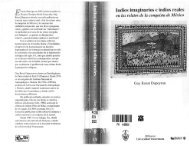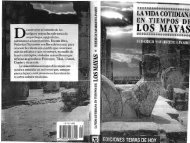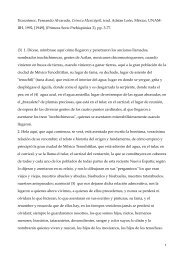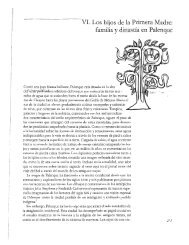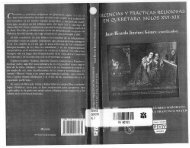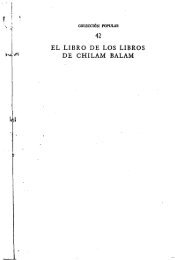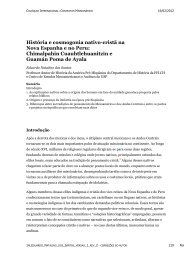1 - Histomesoamericana
1 - Histomesoamericana
1 - Histomesoamericana
Create successful ePaper yourself
Turn your PDF publications into a flip-book with our unique Google optimized e-Paper software.
INTRODUCTION XVÜ<br />
and was supposed to rotate among the subsidiary cities. Commonly more<br />
than one city claimed the honor, which conferred tribute rights, control<br />
of land titles, and appointments to public office. Even the ruined cities<br />
lent their prestigious names to the seating of the katun, and at various<br />
dates between 1461 and 1539 the privilege was claimed by Chichen Itza,<br />
Izamal, Uxmal, Tihosuco, Coba, and Emal.<br />
Early in the sixteenth century, the war of the katuns—or katun of the<br />
wars (u katun katunob)—between the Xiu and the Itza was exacerbated<br />
by the arrival of the Spanish. The result was a formal bifurcation of the<br />
politico-religious system and, coincidentally, a major calendrical reform,<br />
which was promulgated at the beginning of 11 Ahau: 11.16.0.0.0 (1539).<br />
The Itza continued to consider Mayapan to be the seat of the cycle, and<br />
they seated the katun at Emal. The Xiu established Merida as the seat of<br />
both the cycle and the katun. In effect, the peninsula was divided into<br />
eastern and western jurisdictions along a north-south line running right<br />
through Mayapan. A new calendar was announced at Mayapan, with new<br />
yearbearers, a new count of the twenty-day uinals (from 1-20 instead of<br />
0-19], and a count of the katuns by initial date rather than by terminal<br />
date (see the appendix). This calendar, universally used by the colonial<br />
Yucatecans from 1539 to 1752, is in agreement with Landa's statement<br />
that the Mayan new year fell on Sunday, fuly 16, 1553 (see Edmonson<br />
1976).<br />
The Flower katun 11 Ahau thus initiated a new Itza cycle, which was<br />
also the cycle of the Spanish Empire and ended very nearly with the<br />
empire in 1824, at the end of 13 Ahau. The Itza of the sixteenth century<br />
found themselves embattled on several fronts, being opposed by the Spanish<br />
secular and religious authorities, the Xiu nobility, who found it convenient<br />
to become Christians, and the merchants and peasants of both the<br />
east and the west (often also Christianized), who objected to paying tribute<br />
to the Itza as well as taxes to the Spanish. Lowborn claimants to the<br />
lordship of the katun sprang up everywhere, supported by rebellious guerrilla<br />
companies in the woods who made it dangerous and eventually<br />
impossible for the legitimate lords to complete their ceremonial visits to<br />
collect tribute and confirm titles. Few lords of the katun completed their<br />
terms of office. The military companies were not brought under control<br />
until the middle of the seventeenth century, and peasant rebellions continued<br />
long after that.<br />
The Xiu had a long-standing tradition of accommodating foreign culture.<br />
They were considerably more Mexicanized than the Itza even in the<br />
post-Classic period. After the conquest they accommodated similarly to<br />
Christianity and attempted to justify their stance in terms of Mayan<br />
prophecy. By the early seventeenth century, they apparently had lost interest<br />
in the Mayan political game and did not claim to seat the katun<br />
after 1 Ahau (1638-1658). Merida had become the Spaniards' city.<br />
The Itza were more resistant. From the outset of the Spanish conquest<br />
they were troubled by the possible implications of the European calendar,<br />
particularly by the seven-day week, which (leap years being ignored) appeared<br />
to represent a new class of yearbearer that the Maya hadn't<br />
thought of. While the Xiu tried to accommodate the Mexican fifty-two<br />
year divinatory cycle and the Christian year by inventing a twenty-year<br />
(rather than twenty-tun) "katun" (see chapter 22), the Itza clung to the



